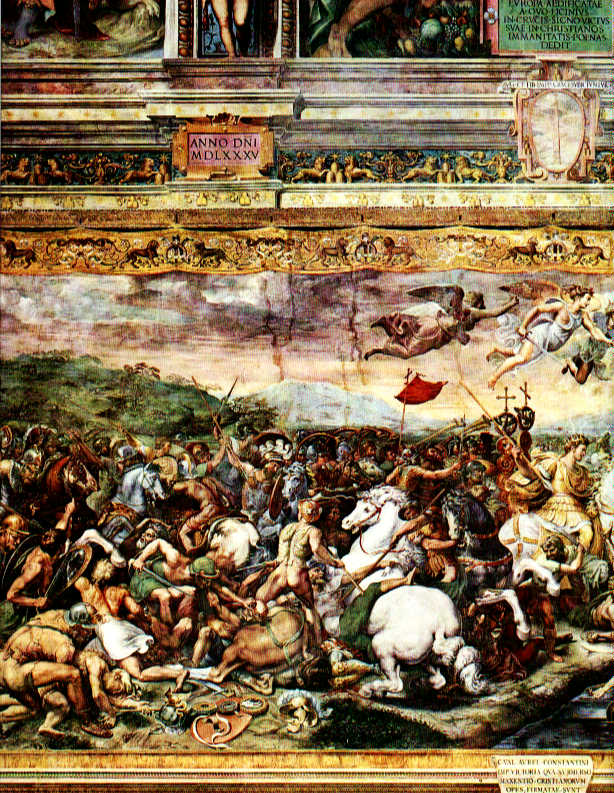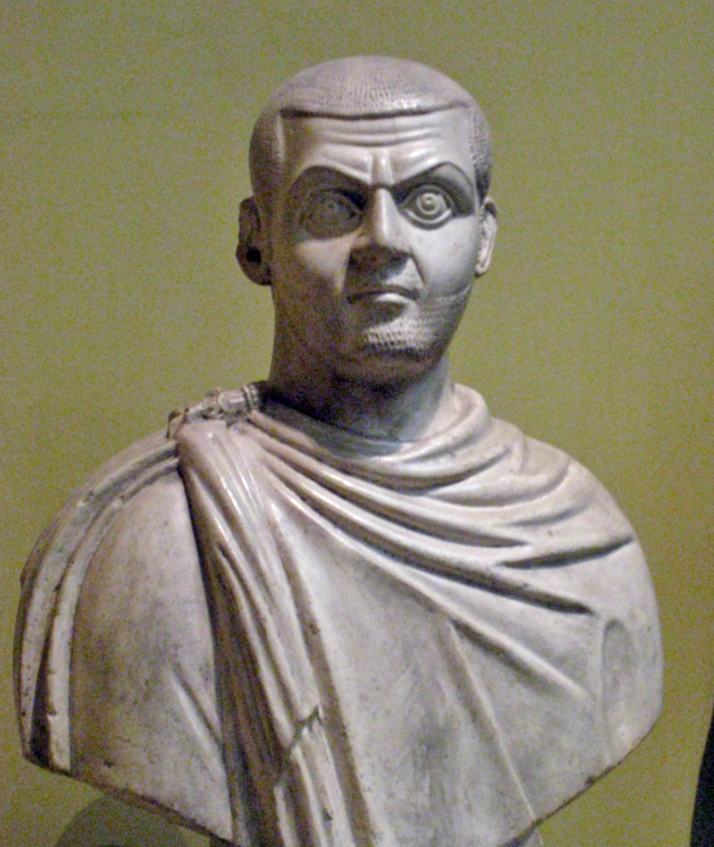|
Civil Wars Of The Tetrarchy
The Civil Wars of the Tetrarchy were a series of conflicts between the co-emperors of the Roman Empire, starting in 306 AD with the usurpation of Maxentius and the defeat of Severus and ending with the defeat of Licinius at the hands of Constantine I in 324 AD. Background The Tetrarchy was the administrative division of the Roman Empire instituted by Roman emperor Diocletian in 293 AD, marking the end of the Crisis of the Third Century and the recovery of the Roman Empire. The first phase, sometimes referred to as the Diarchy ("the rule of two"), involved the designation of the general Maximian as co-emperor – firstly as ''Caesar'' (junior emperor) in 285, followed by his promotion to ''Augustus'' in 286. Diocletian took care of matters in the Eastern regions of the Empire while Maximian similarly took charge of the Western regions. In 293, feeling more focus was needed on both civic and military problems, Diocletian, with Maximian's consent, expanded the imperial college ... [...More Info...] [...Related Items...] OR: [Wikipedia] [Google] [Baidu] |
Maximinus Daza
Galerius Valerius Maximinus, born as Daza (20 November 270 – July 313), was Roman emperor from 310 to 313 CE. He became embroiled in the Civil wars of the Tetrarchy between rival claimants for control of the empire, in which he was defeated by Licinius. A committed pagan, he engaged in one of the last persecutions of Christians, before issuing an edict of tolerance near his death. Name The emperor Maximinus was originally called Daza, a common name in Illyria, where he was born. The form "Daia" given by the Christian pamphleteer Lactantius, an important source on the emperor's life, is considered a misspelling and deprecated. He acquired the name Maximinus at the request of his maternal uncle, Galerius, and his full name as emperor was Galerius Valerius Maximinus. Modern scholarship often refers to him as Maximinus Daza, though this particular form is not attested by epigraphic or literary evidence. Early career He was born in the Roman Illyria region to the sister of em ... [...More Info...] [...Related Items...] OR: [Wikipedia] [Google] [Baidu] |
Edict Of Toleration By Galerius
The Edict of Serdica, also called Edict of Toleration by Galerius, was issued in 311 in Serdica (now Sofia, Bulgaria) by Roman Emperor Galerius. It officially ended the Diocletianic Persecution of Christianity in the Eastern Roman Empire. The Edict implicitly granted Christianity the status of ''religio licita'', a worship that was recognized and accepted by the Roman Empire. It was the first edict legalizing Christianity and preceded the Edict of Milan by two years. History On 23 February 303, on the Terminalia feast, Emperor Diocletian, on the proposal of Galerius, issued a persecutory edict. The edict prescribed: * Destroying churches and burning the Holy Scriptures * Confiscation of church property * Banning Christians from undertaking collective legal action * Loss of privileges for Christians of high rank who refused to recant * Arresting some state officials. In 305, Diocletian abdicated and was replaced by Galerius, his successor, who continued persecution in the East u ... [...More Info...] [...Related Items...] OR: [Wikipedia] [Google] [Baidu] |
Massalia
Massalia (Greek: Μασσαλία; Latin: Massilia; modern Marseille) was an ancient Greek colony founded ca. 600 BC on the Mediterranean coast of present-day France, east of the river Rhône, by Ionian Greek settlers from Phocaea, in Western Anatolia. Marseille is the oldest city of France, and one of Europe's oldest continuously inhabited settlements. History Massalia was established ca. 600 BC by Ionian Greek settlers from Phocaea, in Western Anatolia. After the capture of Phocaea by the Persians in 545 BC, a new wave of settlers fled towards the colony. A creation myth telling the meeting between the Greeks and the local population is given by Aristotle and Pompeius Trogus (see founding myth of Marseille). After the middle of the 6th century BC, Massalia became an important trading post of the western Mediterranean area. It grew into creating colonies of its own on the sea coast of Gallia Narbonensis during the 4th and 3rd centuries BC, including Agathe (late 5th–earl ... [...More Info...] [...Related Items...] OR: [Wikipedia] [Google] [Baidu] |
Conference Of Carnuntum
The Conference of Carnuntum (Latin: ''Carnuntum'') was a military conference held on November 11, 308 in the city of Carnuntum (present-day Petronell-Carnuntum, Austria), which at the time was located in the province of Pannonia Prima. It was convened by the senior emperor of the East (Augustus) Galerius (r. 293-311) as a way to settle the dispute over the title of Augustus of the West and, consequently, to cease the ongoing conflicts since the previous year when he, and before that Severus II' (r. 305-307), invaded the Italy of Maxentius (r306-312) and Maximian (r. 286-308; 310). Present at the conference were Diocletian (r. 284-305), who had been retired since 305, and Maximian. According to deliberations at the meeting, Maximian was to be permanently removed from his imperial position. Licinius (r. 308-324), a former general of Galerius, was appointed as Augustus of the West and was to deal with Maxentius, who had been treated as a usurper. Constantine the Great (r. 306-337) wa ... [...More Info...] [...Related Items...] OR: [Wikipedia] [Google] [Baidu] |
Fausta
Flavia Maxima Fausta ''Augusta'' (289–326 AD) was a Roman empress. She was the daughter of Maximian and second wife of Constantine the Great, who had her executed and excluded from all official accounts for unknown reasons. Historians Zosimus and Zonaras reported that she was executed for adultery with her stepson, Crispus. Family Fausta was the daughter of Emperor Maximian. To seal the alliance between them for control of the Tetrarchy, in 307 Maximianus married her to Constantine I, who set aside his wife, Minervina, in her favour. As the sister of Emperor Maxentius, Fausta had a part in their father's downfall. In 310 Maximian died as a consequence of an assassination plot against Constantine. Maximian decided to involve his daughter Fausta, but she revealed the plot to her husband, and the assassination was disrupted. Maximian died, by suicide or by assassination, in July of that same year. Fausta was held in high esteem by Constantine, and proof of his favour was that i ... [...More Info...] [...Related Items...] OR: [Wikipedia] [Google] [Baidu] |
Roman Gaul
Roman Gaul refers to GaulThe territory of Gaul roughly corresponds to modern-day France, Belgium and Luxembourg, and adjacient parts of the Netherlands, Switzerland and Germany. under provincial rule in the Roman Empire from the 1st century BC to the 5th century AD. History During the Republic The Roman Republic's influence began in southern Gaul. By the mid-2nd century BC, Rome was trading heavily with the Greek colony of Massalia, Massilia (modern Marseille) and entered into an alliance with them, by which it agreed to protect the town from local Gauls, including the nearby Aquitani and from sea-borne Carthaginians and other rivals, in exchange for land that it wanted in order to build a road to Hispania, to assist in troop movements to its provinces there. The Mediterranean settlements on the coast continued to be threatened by the powerful Gallic tribes to the north and in 122 BC the Roman general Gnaeus Domitius Ahenobarbus (consul 122 BC), Gnaeus Domitius Ahenoba ... [...More Info...] [...Related Items...] OR: [Wikipedia] [Google] [Baidu] |
Tres Tabernae
Three Taverns ( la, Tres Tabernae; , ''Treis Tabernai'') was a place on the ancient Appian Way, about 50 km (31 miles) from Rome, designed for the reception of travellers, as the name indicates. History Tres Tabernae originated as a statio (Roman), post station on the Appian Way ( la, Via Appia), around the 3rd century BC. Here, the Christian saint Paul of Tarsus, on his way to Rome, was reportedly met by a band of Roman Christians (''Acts of the Apostles, Acts'' 28:15). The "Tres Tabernae was the first ''mansio'' or ''mutatio'', that is, halting-place for relays, from Rome, or the last on the way to the city. At this point three roads run into the Via Appia, that from Tusculum, that from Alba Longa, and that from Antium; so necessarily here would be a halting-place, which took its name from the three shops there, the general store, the blacksmith's, and the refreshment-house...Tres Tabernae is translated as Three Taverns, but it more correctly means three shops". The Encyclop ... [...More Info...] [...Related Items...] OR: [Wikipedia] [Google] [Baidu] |
Ravenna
Ravenna ( , , also ; rgn, Ravèna) is the capital city of the Province of Ravenna, in the Emilia-Romagna region of Northern Italy. It was the capital city of the Western Roman Empire from 408 until its collapse in 476. It then served as the capital of the Ostrogothic Kingdom until it was re-conquered in 540 by the Byzantine Empire. Afterwards, the city formed the centre of the Byzantine Exarchate of Ravenna until the last exarch was executed by the Lombards in 751. Although it is an inland city, Ravenna is connected to the Adriatic Sea by the Candiano Canal. It is known for its well-preserved late Roman and Byzantine architecture, with eight buildings comprising the UNESCO World Heritage Site "Early Christian Monuments of Ravenna". History The origin of the name ''Ravenna'' is unclear. Some have speculated that "Ravenna" is related to "Rasenna" (or "Rasna"), the term that the Etruscan civilization, Etruscans used for themselves, but there is no agreement on this point. Ancien ... [...More Info...] [...Related Items...] OR: [Wikipedia] [Google] [Baidu] |
Mediolanum
Mediolanum, the ancient city where Milan now stands, was originally an Insubrian city, but afterwards became an important Roman city in northern Italy. The city was settled by the Insubres around 600 BC, conquered by the Romans in 222 BC, and developed into a key centre of Western Christianity and informal capital of the Western Roman Empire. It declined under the ravages of the Gothic War, its capture by the Lombards in 569, and their decision to make Ticinum the capital of their Kingdom of Italy. During the Principate the population was 40,000 in AD 200; when the city became capital of the Western Roman Empire under emperor Maximian (r. 286–305), the population rose to 100,000 people and thus Milan became one of the largest cities in Roman Italy. History Mediolanum appears to have been founded around 390 BC by the Celtic Insubres, after whom this region of northern Italy was called Insubria. According to the legend reported by Livy, the Gaulish king Ambicatus sent his ... [...More Info...] [...Related Items...] OR: [Wikipedia] [Google] [Baidu] |
Rome
, established_title = Founded , established_date = 753 BC , founder = King Romulus (legendary) , image_map = Map of comune of Rome (metropolitan city of Capital Rome, region Lazio, Italy).svg , map_caption = The territory of the ''comune'' (''Roma Capitale'', in red) inside the Metropolitan City of Rome (''Città Metropolitana di Roma'', in yellow). The white spot in the centre is Vatican City. , pushpin_map = Italy#Europe , pushpin_map_caption = Location within Italy##Location within Europe , pushpin_relief = yes , coordinates = , coor_pinpoint = , subdivision_type = Country , subdivision_name = Italy , subdivision_type2 = Region , subdivision_name2 = Lazio , subdivision_type3 = Metropolitan city , subdivision_name3 = Rome Capital , government_footnotes= , government_type = Strong Mayor–Council , leader_title2 = Legislature , leader_name2 = Capitoline Assemb ... [...More Info...] [...Related Items...] OR: [Wikipedia] [Google] [Baidu] |






.png)
